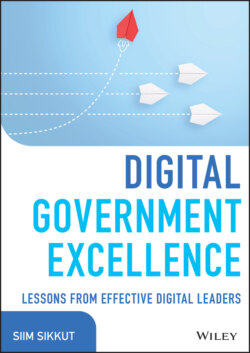Читать книгу Digital Government Excellence - Siim Sikkut - Страница 10
INTRODUCTION
ОглавлениеWhenever government CIOs or colleagues with similar titles and responsibilities meet, be it within a country or at an international level, it is like a support group meeting of sorts. We listen to each other's challenges and trials; we bounce ideas off each other about how to solve them and share practical insights on what we have tried ourselves for it. We lean on each other to hear if anything has worked well or not—and then perhaps copy that practice.
This is natural, because peer-to-peer sharing and learning are one of the most valuable ways to learn. At the end of the day, our jobs and, therefore, the joys and troubles are very similar country to country or organization to organization.
There is a growing number of international and other groupings, annual events, and chat channels for peer learning in the digital government space. One of the reasons is that the good practices and country examples are still too seldom codified and mostly spread through word-of-mouth only. Too often, these conversations and learnings stay just between people and closed doors, or direct chat channels.
However, digital government is a growing phenomenon and movement all over the world, in latest part because of COVID-19 pandemic's (one good) impact. There is a growing eagerness around the world to digitally transform governments—to take the public services and governance to a digital era, finally. Yet, actual success and achievement in building out a digital government greatly varies among countries as well as within them, with many failed or stalled attempts.
Thus, there is a growing demand to learn how to really build a digital government that works well. That is why there should be value and interest for the sharing of the relevant leadership or management lessons more widely.
And that is why the idea for this book was born. As a digital government leader myself until recently, I always yearned to hear from peers how they did what they did, how were they solving some strategy or management or other issue that I encountered in my work.
In my ten years in this business, I have had the good fortune to meet literally hundreds of digital leaders from all kinds of geographic, sectoral, and digital maturity backgrounds. Each time I picked their brains and their practical experience drawers for tips and tricks. That is what got me thinking—could we somehow make these nuts of insights available more widely?
In a way, there already exists a lot of research and writing on how governments have, can, and should build up a digital government. You can easily find cases and guidelines on what should be the strategy and the policies to make the most of digital technology for improving public services and policy delivery. Such literature covers either or both the theoretical models as well as practical case study angles. A range of international institutions and all kinds of consultancies work daily to compile and disseminate these kinds of findings and know-how.
Attention has also been paid to how to build relevant institutional conditions and mechanisms for digital government progress. Similarly, a body of literature and online advice is growing for practitioners on how to build up public sector teams to really deliver on the digital efforts: why and how to start digital (transformation) agencies or ministries, or even digital teams within various departments, borrowing bits of practice and know-how from private sector companies.
In this existing pool of very useful knowledge, surprisingly, only very little attention has been paid so far to leaders and leadership as one core component of achieving digital government excellence.
If you study history or management, you learn that great achievement and changes always are the sum of factors combined: a good plan, a good set-up and institutions, good leaders with effective practices. In other words, it takes great individual leaders to make things happen in a great way in great groups in right context.
Hence, this book. It is an attempt to provide a tour guide or playbook on how to achieve digital government excellence in terms of how to best lead such efforts and the relevant teams. Perhaps tour guide or playbook are not the best terms, because I do not even pretend to provide comprehensive models and a full checklist.
However, you do find in this book a range of tried-and-proven leadership practices and learnings from seasoned practitioners on how to make digital government reforms a success. They come in the form of firsthand accounts of leadership stories and tips from twenty globally renowned digital government leaders—from governments in all parts of the globe.
It is a collection of interviews with remarkable people who have led their governments to digital government excellence. These are their stories, in their own words, about some of the core dilemmas that practitioners are dealing with the most in digital government leadership jobs. I opted for the story or interview form because stories (case studies) have been proven to be one of the most effective methods to really learn from others.
Similar-style books have been compiled about private sector digital transformation leaders, but these are not entirely relevant to public sector specifics—although many insights can be surely transferred, too.
So, this long story finally short now. This book was written because the topic of digital government is increasingly hot, and governments and practitioners yearn for learning the best practices on how to make it all work. No one has assembled the lessons of relevant best leaders so far. The book presents shining examples of what good looks like in digital government leadership and management sense.
